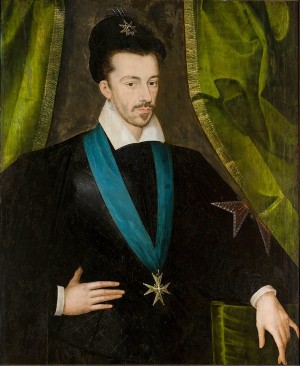The memorable party of 1574 in honour of the king of France

François Quesnel (attribuito a), Ritratto di Enrico III di Francia, olio su tavola, 1580 circa, Poznañ, Museo Nazionale
The slopes of the colossal Montagna di San Giorgio were illuminated by an abundance of lights for the banquet organised by Alfonso II d’Este in honour of King of France, Henry III of Valois, on the evening of 30 July 1574.
Historical notes
The various forms of documentation that exist on the subject agree that the spectacular banquet held on the slopes of Ferrara’s ‘mountain’ on the evening of 30 July 1574 was nothing short of unforgettable: the guest of honour was none other than the new king of France, Henry III, who was on his way back from Poland, accompanied by the dukes of Angoulême, Nevers and hundreds of other dignitaries. A few days earlier, a wooden loggia was built, painted with faux marble and tympanums, decorated with architectural details entirely sculpted in plaster, as were the cherubs on the walls that held the torches. Below the imposing structure, richly embellished with veils, garlands and silk flowers, guests took their seats, flanked by 80 ladies from Ferrara that Alfonso II made sure were dressed in gold brocade, despite the summer heat. His goal was to show off the opulence of Este nobility under the his protection, conveyed through the luxurious wardrobe of the dames.
For the event, the two grottoes in the mountain were turned into veritable cabinets of curiosities: splendour made way for astonishment when facing the deceptive mirrors applied to the ceiling and perhaps even to the walls. They multiplied forms, deformed images, amplified the light of the sun reflected by strange octagonal pyramids covered in glass placed at the top.
In order to prepare the stages of the various shows and performances put on for the dinner guests, a large number of painters, carpenters, architects, tailors and gardeners were assembled in record time. Indeed, painter Rinaldo Costabili alone created fifty plaster knights, each seated atop a mechanical horse, part of an army assembled to attack the fairy-tale wooden castle built directly on the water of the great fish pond, which was over 200 metres long (located at the base of the mountain, along present-day Viale Alfonso I d'Este). The castle, designed by Pirro Ligorio and Marco Antonio Pasi, was covered with canvases ‘painted with fine art’ by Giulio Marescotti and Giuseppe Mazzuoli, who was known as ‘il Bastarolo’.
The event was made truly unique by a pyrotechnical display and iridescent waterfalls dropping directly from the towers of the floating castle. It all was to the amazement of the French king, until a tragic accident occurred: a few overhead fabric coverings suddenly caught fire within the castle, triggering a blaze that killed many of the operators hidden within it to control the special effects, in addition to seriously injuring those who managed to escape and jump into the water of the pond. This disaster had a profound effect on the superstitious Henry III, who left Ferrara the following day with little further ado.
Bibliography
- Pierre de Nolhac, Angelo Solerti, Il viaggio in Italia di Enrico III re di Francia e le feste a Venezia, Ferrara, Mantova e Torino, L. Roux, Torino 1890
- Angelo Solerti, Ferrara e la corte estense nella seconda metà del secolo decimosesto. I discorsi di Annibale Romei gentiluomo ferrarese, Lapi, Città di Castello 1900
- Andrea Marchesi, Grotte, Montagne e fontane estensi. Natura artificiata nella Ferrara del Cinquecento, in Gianni Venturi, Francesco Ceccarelli (a cura di), Delizie in villa. Il giardino rinascimentale e i suoi committenti, Olschki, Firenze 2008
- Andrea Marchesi, Delizie d'archivio. Regesti e documenti per la storia delle residenze estensi nella Ferrara del Cinquecento, Tomo II, Dimore urbane, Le Immagini edizioni, Ferrara 2015
Compiling entity
- Assessorato alla Cultura e al Turismo, Comune di Ferrara
